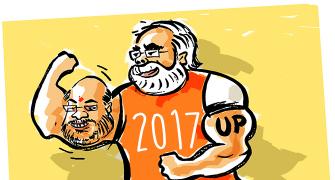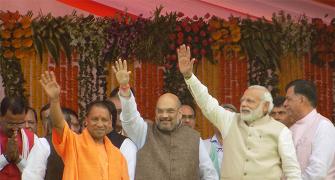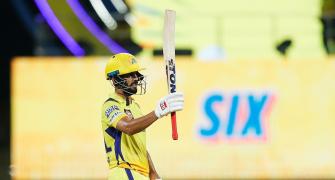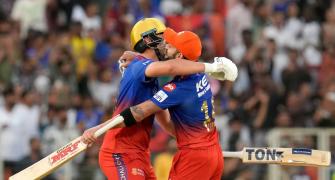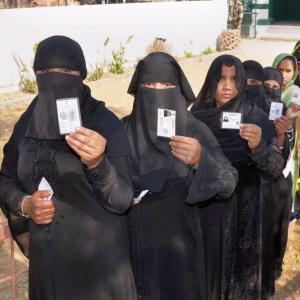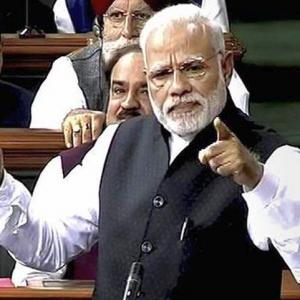What does one deduce from this silence? That the minorities in the BJP era have been muted, perhaps even coercively, asks Sajad Ahmad Dar.
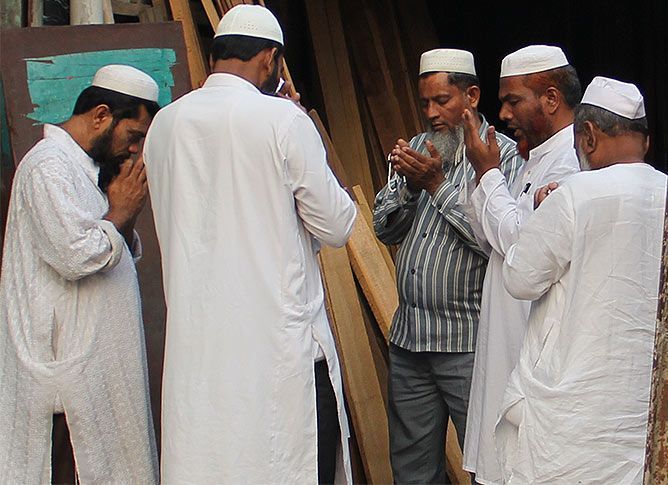
On August 7, 2017, a person named Suresh (a historysheeter) allegedly killed two brothers (Mohammad Wasim, allegedly with criminal antecedents, and Mohammad Aashu), with who he was otherwise acquainted.
This twin murder was carried out at one of the busiest places in Aligarh city, the Railway Road, in broad daylight.
Given the fact that the city is historically prone to communal violence, the incident, it was feared, was likely to degenerate into communal violence.
Fortunately, it did not.
The town has previously experienced several major communal clashes -- in 1961, 1971, 1978 and 1990-91.
However, since 1991, there has been no major communal violence in Aligarh (except a relatively minor clash in 2006), which in itself needs academic probing as to how and why this city, prone to communal violence, has remained peaceful for more than 25 years.
The United States-based political scientist, Paul Brass, in his book, Production Of Hindu-Muslim Violence In Contemporary India (2003), has written a comprehensive political history of communal violence in Aligarh.
The thrust of his argument is: The violence is politically engineered/produced, rather than spontaneous. He therefore classifies it into three stages: rehearsal/preparation, activation/enactment and explanation/interpretation.
But the question here is why did the twin killing of Muslims by a Hindu not degenerate/flare up into a riot? Was it because:
- One of the victims was supposed to be a criminal?
- The victims resided in a Hindu majority locality in the city and hence did not have much clout within their co-religionists?
- The two killed did not belong to the community of Qureshis, the upwardly mobile community of Muslims who are supposed to be little more organised and assertive in retaliating in Aligarh, but to the non-Qureshi Pasmanda biradri (caste) of Muslims --- Bhishti (water-carrier), in their case?
- Fear that the Bharatiya Janata Party, which is in power at both the Centre and in the state, may have instructed the police to repress the protests or the retaliation?
Elisabeth Mann, in her study of Aligarh, Boundaries And Identities (1992), identifies 24 Muslim biradris in the city, among which the most 'prominent', socially, economically and politically in her view are, the Qureshis (the meat-sellers), the Ansaris (the weavers), the Saifis (the ironsmiths) and the Pathans.
The first three would fall in the Pasmanda category, whereas the last would fall in the Ashraf category.
Of these, as said earlier, the Qureshis are supposed to have undergone 'rapid economic growth' and have produced Muslim politicians like Mohammed Sufiyan of the Janata Dal.
The Qureshis have often been at loggerheads in electoral politics with the Saifis, who are comparatively relatively backward in this part of the country. Yet, from the community of Saifis, Abdul Khaliq of the Samajwadi Party registered an electoral success in 1996 when he was elected to the state assembly.
The interesting thing about the incident on August 7 was that the Muslim communities of the town did not respond immediately. This ‘inaction’ broke only after a statement came from the BJP MLA of Aligarh, Sanjeev Raja.
He justified the killings as an act of 'self-defence'.
Quite expectedly, his remarks were provocative enough to worsen the situation.
On August 11, a section of Muslim youth protested against his statement after offering the Friday afternoon prayers.
Raja's statement had created a strong apprehension among a section of Muslims in the city that the state machinery would be influenced to unduly safeguard the accused.
The protesters were also asking for a compensation of Rs 50 lakh for the family of the deceased. Some of the protesters reportedly resorted to throwing brickbats. The police had to use lathi charge, teargas and chilli bombs to control the irate mob.
A host of questions arise from the criminal incident.
The accused, Suresh, reportedly fired four shots from a distance of about 50 metres, which clearly demonstrates that it was not an act of ‘self-defence’. The firing, to those present at the spot who insist on their anonymity, had no provocation nor had a scuffle taken place between the shooter and the deceased.
Sanjeev Raja’s utterances re-confirm what Paul Brass had argued, that the promoters of violence recognise its illegitimacy by claiming that the aggressor community was only acting in 'self-defence'.
There is, however, more to the incident than meets the eye.
The victims are the only Muslim family living in what otherwise is a predominantly Hindu locality.
This takes us to the ‘economics of a murder’ and also corroborates one of my interviewee’s views that the murders were carried out because Suresh was eyeing the property of the deceased.
Thus, one may argue that the murders were carried out in order to terrify or intimidate the family of the deceased and force them to leave the locality.
India, more specifically Aligarh, has a long history of cases where a minority is subjected to such tactics and forced to leave the place and go live in ‘ghettos’.
The most noticeable thing -- and which seems to have become a norm today -- is that while the SSP and the district administration should have taken action against the MLA for his provocative remarks, they instead were busy in lodging cases against those demanding action against the MLA and justice for the two deceased.
The protest by the community was video-graphed by the police. More than hundred Muslims have already been booked.
However, the district administration is hell bent upon adding more to the list.
The inaction against the BJP MLA sends a message that the enforcers of the law have chosen to act in a partisan manner. Yet, there has not been any protest and significant reportage about the role the police have played.
Even though an old, centrally funded, large, residential Muslim university is located in the city, quite intriguingly, hardly any voice of protest against the role of the police and the BJP MLA could be heard.
What does one deduce from this silence? That the minorities in the BJP era have been muted, perhaps even coercively?
But even in the pre-BJP era, there were instances of such silence.
For instance, the Muslim leadership did not ask for justice in the Aligarh riots of 1990-91, when a 'Muslim friendly regime' headed by Mulayam Singh Yadav was in power.
Similarly, the Muslim leadership hardly ever asked then chief minister Lalu Prasad Yadav to deliver justice by booking the culprits in the Bhagalpur riots (1989-90), and Sitamarhi-Riga riots (October 1992).
Even in the 2013 Muzaffarnagar riots, the wilful failures of the Akhilesh Yadav regime in preventing, and controlling, the riots, in rehabilitating the victims and in bringing the perpetrators to justice has largely been ignored by Muslim politicians and the intelligentsia, as also by the liberal-left.
Unlike the 2002 Gujarat riots, the perpetrators and collaborating police officers have not been chased by civil society groups up to the higher judiciary. Let us recall that, in the case of Gujarat, some high-ranking police officers and even ministers have been incarcerated; some have even been convicted.
Usually, some of the vocal Muslims are co-opted by the 'friendly regimes' and this is how their silence on acts of injustice are, in a sense, purchased.
The only difference this time, in the era of BJP’s dominance and hegemony, is that they have been muted without any favour being offered to individual elites of the community.
'Even the intelligentsia has become palpably partisan. They shout against the omissions and commissions of saffron establishments, but they choose to become less shrill and less strident when they are needed to speak against the non-saffron forces. The liberals, for instance, did not speak out against Akhilesh Yadav’s regime whose police in Dadri (September 2015), in Muzaffarnagar (2013), and elsewhere in Uttar Pradesh failed to uphold Constitutional values,' Prof Mohammad Sajjad has argued on Rediff.com.
It may perhaps be argued that this kind of political practice in the past (in the 'pre-BJP era') has contributed towards a lack of confidence and moral courage in speaking out against such issues. Therefore, now, when more than 100 Muslims were arrested for protesting against the provocative remarks of the BJP MLA, it seems to have gone unnoticed by civil society.
This also raises questions about the political and intellectual efficacy of the Muslim university.
The Aligarh Muslim University Teacher’s Association, the Aligarh Muslim University Student’s Union, and informal students’ groups like the Aligarh Activist’s Society and the students of AMU, did not speak out on the issue.
Even the Urdu dailies did not carry opinion pieces on this kind of partisan administrative repression in Aligarh in August 2017.
Isn’t it, then, time for deep introspection?
Sajad Ahmad Dar is pursuing doctoral research on the urban history of Aligarh in the 20th century, at the Centre of Advanced Study in History, Aligarh Muslim University.

